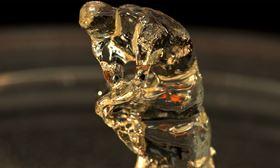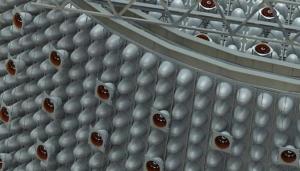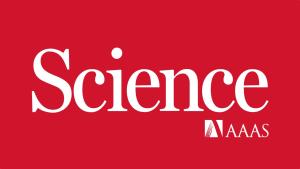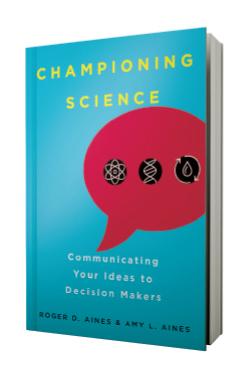LAB REPORT
Science and Technology Making Headlines
Feb. 8, 2019


Rodin’s “The Thinker” was printed by computed axial lithography. Photo by Stephen McNally/ UC Berkeley
Replicator becomes reality
Much like the sci-fi replicator in Star Trek that could instantly replicate anything the crew might need, Lawrence Livermore scientists and UC Berkeley colleagues have created a new 3D method for instantaneously producing small objects in a matter of minutes.
It looks very much like Star Trek’s replicator, but instead of fictionally dismantling objects into sub-atomic particles or actually slowly 3D printing something layer by layer, the new approach projects light into resin, which objects in a matter of minutes.
The new technology is based on the principles of computed tomography (CT), frequently used in medical and industrial 3D imaging, but never before used in the process of fabrication. But where traditional 3D imaging takes multiple X-rays to produce a 3D map, this tech reverse engineers the 3D object into 2D components, which are then projected as slides of light into the gooey resin.
The process involves rotating a container of light-sensitive material, while projecting into it a sequence of computed light intensity patterns that are synchronized with the rotation. Over time, a 3D pattern of light energy is delivered to the material by more than a thousand different projections. Where the energy delivered exceeds a critical threshold, the material undergoes a chemical reaction and the part is formed.


Different agricultural practices could help soils store more carbon.
Capturing carbon is a dirty job
Global emissions of carbon dioxide keep rising despite years of policy efforts to control them. The world has already warmed by 1.8 degrees Fahrenheit; to prevent a temperature rise of 3.6 F or more — after which millions of people are likely to face dangerous heat waves and droughts — many scientists argue that a new strategy must be added to the mix.
There are different ways to pull carbon dioxide from the air. One is to boost Earth’s natural carbon sinks, such as planting more forests or restoring seagrass beds. Nature-based methods for CO2 removal also include sequestering carbon in soils, as with the Ideal plant (one that will help curb global warming) or by using different agricultural practices such as no-till farming, which can help soils store more carbon.
“We are very interested in soil carbons because over the course of recent human history, we have lost the equivalent of 450 billion tons of carbon dioxide from agricultural soils,” says Roger Aines, head of negative emissions research at Lawrence Livermore National Laboratory.


Possible configuration of the photomultiplier tube mounting structure for the WATCHMAN antineutrino detector.
Watch this, man
Set to be built 1.1 kilometers underground at the ICL Boulby mine in North Yorkshire, the 6,500-ton WATCHMAN detector will measure antineutrinos, which are harmless sub-atomic particles emanating from sources that include nuclear power stations.
The UK-U.S. project was awarded 9.7 million pounds from the UK Research and Innovation’s new Fund for International Collaboration in January. If successful, the Advanced Instrumentation Testbed (AIT)-WATCHMAN project could lead to a scaled-up instrument designed to improve global security by tracking nuclear-weapons-grade materials.
Project partners at Lawrence Livermore National Laboratory said the depth of AIT-WATCHMAN means that naturally occurring cosmic ray particles — which continuously bombard the Earth’s surface — are reduced in rate by several orders of magnitude, removing a background that would otherwise interfere with the antineutrino signal of interest from a nuclear power station some 25 kilometers away.


“Championing Science: Communicating Your Ideas to Decision-Makers” was written by LLNL scientist Roger Aines and communication specialist Amy Aines.
Communication champs
As government funding for scientific research has become increasingly scarce, more scientists are turning to nontraditional sources, including philanthropic organizations, patient advocacy groups and angel investors, to support their work.
It's no secret that effective science communicators are the most successful in the grants arena. As a result, a range of books, websites, videos and workshops devoted to improving communication between scientists and the public are being marketed increasingly to the scientific community.
One admirable addition to this field is “Championing Science: Communicating Your Ideas to Decision-Makers.” Written by practicing Lawrence Livermore scientist Roger Aines and scientific communication specialist Amy Aines, this book offers a practical guide to optimizing all aspects of communication. Its aim is specific: to use proven methods to motivate decision-makers and colleagues to support, fund and implement work.
The Aineses' approach hinges on a concept the authors refer to as “self-awareness and self-correction.” They argue that a keen awareness of one's personal style and an openness to external feedback can help an investigator modify rough spots and smooth out his or her presentation, with more efficient transfer of information being the welcomed byproduct.


LLNL received and Employees Choice Award from Glassdoor and came in at No. 24 for the 100 Best Places to Work in U.S. companies with more than 1,000 employees.
The happiest place to work
If you're looking for a new job, you might want to check out companies where employees are happier than the norm. Job and recruiting site Glassdoor released its annual ranking of the best places to work, which takes into account its database of 45 million company reviews provided by anonymous current and former workers.
Lawrence Livermore National Laboratory was recognized as one of 2019’s “Best Places to Work” by Glassdoor.
LLNL received an “Employees’ Choice Award” based on more than 500 reviews submitted to Glassdoor by current and recent employees. The Lab came in at No. 24 for 100 Best Places to Work in the category for U.S. companies with more than 1,000 employees.
In reviews submitted to Glassdoor, employees celebrated their top-notch co-workers, as well as LLNL’s cutting-edge research and world-class facilities. Employees also said that the environment at LLNL promoted a healthy work/life balance.





